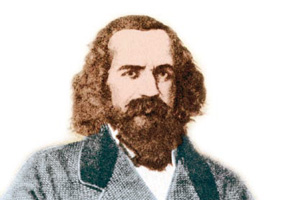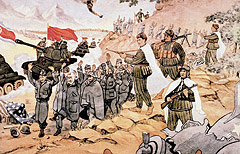Jose Joaquin Perez Mascayano assumed the position of president of the Republic on September 18th of 1861. In despite of his connection with the National Party, he was considered a conciliatory figure and had the support of all the political parties. This was clearly reflected on the confirmation of his first cabinet, integrated by liberals, conservatives and nationals.
During the first ten years that Perez Mascayano governed, a series of works were done oriented to the national development and progress. In matters of public works, the railroads were expanded in the central zone of the country. One of the most important railroad layout was implemented between Valparaiso and Santiago, such works were supervised by the north American entrepreneur Enrique Meiggs. In addition, he was in charge of building the bridge over the Maipo river.
The communications inside of the country also improved, by extending the telegraph lines as far as Nacimiento. The mailing system, created in 1851, was modernized, taking advantage of the new road system available in the country.
However, the boldest works done during the office of Jose Joaquin Perez were two constitutional reforms which meant an advance in social and political matters. On one hand, in 1856 the necessity of reforming article N° 5 of the Constitution of 1833 was proposed, which established that «The religion of the Republic of Chile is the catholic, apostolic, roman, with the exclusion of the public practicing of any other». After many debates, on July 27th of 1865 a law was enacted which allowed those who were not catholic to practice their cult «within the walls of privately owned buildings», which constituted an important advance in the freedom of worship.
The other important reform referred to the termination of the immediate reelection of the President of the Republic starting in 1871, thus establishing thereof 5 year governments. For this reason, Jose Joaquin Perez is the last of the ten-year term presidents.
Armed agitation
Since the middle of the XVIII century, an americanist feeling developed in our country which was not perceived since Independence times.
Intellectual and politicians, among them Manuel Antonio Matta and Victorino Lastarria, supported the cooperation and brotherhood between the countries of the continent and looked with suspicion at the events that were proof of an imminent European colonizing charge.
The conditions were then favorable for Chile to get involved, at first as an act of solidarity , in an armed conflict that started outside the limits of the country and ended with the bombing of Valparaiso.
On April 30th of 1862, news arrived to our country that the Chincha islands, belonging to Peru, had been invaded by Spanish forces.
The European power had not yet recognized the Independence of the neighbor country, claiming a pending debt from the times of the Colony which would be paid off by taking over the natural resources that the islands had and the main source of economical resources of Peru: guano.
Before these serious events, our country stayed in a state of alert. It offered solidarity to Peru and criticized the actions of Spain, considering it as an attack against the sovereignty of the American states.
The conflict was then only treated on a diplomatic level, thus realizing a Congress of American Delegates in 1864 to revise the issue, in which Bolivia, Ecuador, Colombia, Venezuela, Argentina and Guatemala participated.
While the moods were pacified and an agreement between Peru and Spain was subscribed, there was an existent nuisance on the Spanish people due to the attitude of Chile, which led to the sending of a document in which Spain required the rendering of honors of the Chilean government, by shooting 21 cannons in the port of Valparaiso. The reaction of our country was immediate, and with the approval of Congress, the president Jose Joaquin Perez declared the war against Spain on September 25th of 1865.
Immediately, the Spanish ships blocked the most important ports of the country, among them were Valparaiso, Talcahuano, Coquimbo and Caldera. In the middle of this display, the Chilean commander Williams Rebolledo achieved to ambush and capture the Spanish schooner «Covadonga», in the naval combat of Papudo, on November 26th of 1865. This not only represented and important triumph for the national Squadron, but also meant a strong morale boost for the Spanish soldiers, since they lost their main conductor, the commander Manuel Antonio Pareja, who after the defeat, committed suicide.
After that, Chile received the support from other American countries, who impeded supplying to the Spanish and continued with a series of victories, standouts among them were the battles of Abtao (February 7th, 1866) and Huito (March 2nd, 1866). Spanish forces faced complications and acted senselessly. However, the instructions coming from the Iberian peninsula were strict: they had to avenge the dishonorable affront and in order to do so, one of the best options was to bomb the country’s most important port, Valparaiso.
It is so that on March 31st, 1866, specific strategic points of the port city were devastated by the Spanish attack. Customs, the stock exchange and the Intendancy were some of said points, beginning a serious fire that left great economic losses to the city and encouraged rejection from the national population for the Spanish actions. Not satisfied with this, the Spanish squadron tried to repeat this action at Callao, where they encountered resistance from Peruvian forces, reason for which they ultimately retreated with course to the Philippines, absolutely defeated.
Although our country signed an armistice with Spain, Peru, Bolivia and Ecuador on April 11th, 1871, it was only on July 12th, 1883 that Chile ratified the Peace and Friendship treaty with Spain.
Occupation of the territory
Also during the government of Jose Joaquin Perez, an important colonizing campaign began, which years later would configure the new physiognomy of the territory. All of this would begin with the appearance of an anecdotic character at the south of the country.
At the end of 1861, Orelie Antoine de Tounens, a Frenchman, settled in the Araucania and self-proclaimed himself king of the zone and of Patagonia.
Taking advantage of the scarce presence of Chileans in the zone stretching between the Biobio and Tolten rivers, the adventurer managed to convince a few caciques (chiefs) that still resisted Chilean authority and organized a kind of kingdom in the area.
After two years of agitation and revolt he was detained by the troops commanded by Cornelio Saavedra. He was judged and banished to his country of origin. But, beyond becoming a strange anecdote of our history, the actions of the adventurous Frenchman motivated the government to incorporate the zone into our national sovereignty. This way, in 1862, the first official action taken to integrate the Araucania began under the charge of colonel Saavedra. Commanding nearly 1,500 men, he managed to gradually make his way south of the biobio. During the first stage he founded Mulchen, Angol and Lebu. From there, the border was moved to the Malleco river between the years 1867 and 1868, strengthening the presence of national troops with the creation of forts in Collipulli (1867), Cañete (1868) and Puren and Lumaco (1869).








 Termina la Guerra de Corea
Termina la Guerra de Corea